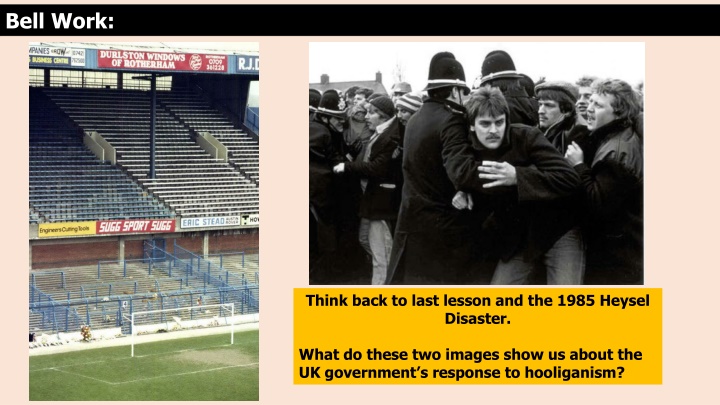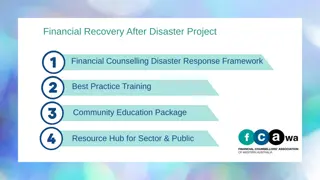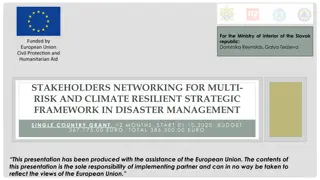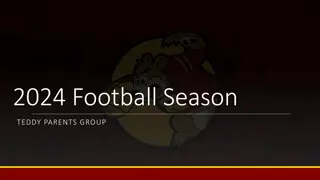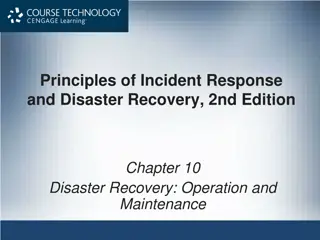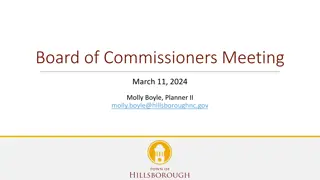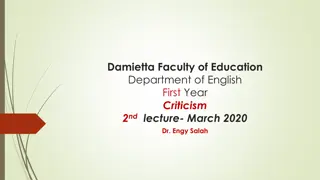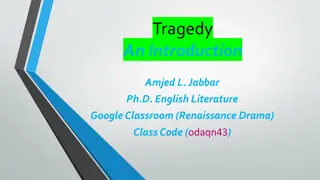Government Response to Football Hooliganism: Heysel Disaster and Hillsborough Tragedy
The UK government's response to hooliganism in football during the 1980s, as illustrated by the Heysel Disaster and the Hillsborough Tragedy, reflected a strategy of heavy policing, installation of cages in stadiums, fan arrests, and bans. Despite these efforts, incidents like the Hillsborough Disaster in 1989, where 96 fans lost their lives due to a crowd crush, raised questions about accountability and safety in sports events.
Uploaded on Sep 20, 2024 | 5 Views
Download Presentation

Please find below an Image/Link to download the presentation.
The content on the website is provided AS IS for your information and personal use only. It may not be sold, licensed, or shared on other websites without obtaining consent from the author.If you encounter any issues during the download, it is possible that the publisher has removed the file from their server.
You are allowed to download the files provided on this website for personal or commercial use, subject to the condition that they are used lawfully. All files are the property of their respective owners.
The content on the website is provided AS IS for your information and personal use only. It may not be sold, licensed, or shared on other websites without obtaining consent from the author.
E N D
Presentation Transcript
Bell Work: Think back to last lesson and the 1985 Heysel Disaster. What do these two images show us about the UK government s response to hooliganism?
Lesson Aim The Hillsborough Disaster - Is there always someone to blame?
Starter: Source A: If we do not [do something] there is a real danger that football will die for lack of support, because only thugs will go to watch it Football is sick, it may be terminal. Nicholas Keith, chief sports editor of The Times, 19 September 1980 Last lesson we considered the increasing violence seen in football during the 1980s. This led to the Heysel Disaster where British fans clashed with Italian supporters in 1985, 39 people were killed and over 600 were injured. If you had to fix the problem of hooliganism in the 1980s, what would you do?
How did the government fight hooliganism? The British government chose to fight against hooligans with lots of policing and some harsh methods. The Prime Minister, Margaret Thatcher: We have to get the game cleaned up from this hooliganism at home . Cages were installed into the stadiums lock fans in, to try and stop fans getting onto the pitch and stop fans from getting to the opposition supporters. Lots of fans were arrested at football matches and banned from coming back into stadiums. Police would not be afraid to fight back against fans. Even after the Heysel Disaster, some fans still not stop trying to cause problems and violence at football matches and are even more angry at the government.
What happened at Hillsborough? https://www.youtube.com/watch?v=J6kAtdwNJ5s 3 mins
What happened at Hillsborough? On 15th April 1989, 96 football fans were killed and 766 injured at the FA Cup semi-final match between Liverpool and Nottingham Forest at Hillsborough Stadium, Sheffield. Liverpool fans were excited to potentially reach another cup final and were heading into Hillsborough Stadium through the Leppings Lane end of the ground. As the game got closer to kick-off, stewards and police did not think all of the fans would get in to see match start. The decision was made to stop checking tickets properly, and allow fans to flood into the ground through open gates. Fans were pushed mainly into pens 3 and 4, many thousands of fans kept joining the pens. The people at the front of the stands were trapped and could not escape because of the cages. A crush happened, people at the back not knowing what was happening at the front. The game was in the 6th minute and was stopped as people realised how serious the situation was. It was the worst disaster in British sport s history.
The Hillsborough Disaster - Is there always someone to blame? On 15th April 19___, Liverpool were due to play Nottingham Forest in the ___ _____ semi-final at Hillsborough Stadium, Sheffield. Sadly, tragedy struck as fans in the Liverpool supporters end were _________ against the cages in the stands. ____ fans were killed and the disaster shocked the whole of Britain. In the days that followed the Hillsborough disaster people began to look for someone to ______. How was it acceptable that people could attend a football match and never return home to their families? British football had been suffering a ____________ problem and lots of people mistaken believed that hooligans had caused this terrible disaster. _____ _____ newspaper did not help this by publishing a headline entitled The Truth , where Liverpool fans were accused of causing the disaster with hooliganism and other criminal acts. Every accusation was proved as false and in 2014, The Sun s editor described it as the greatest mistake the paper s history . However, the ________ was done and many believed Liverpool were to blame. In 19___, it was announced that the deaths that day were __________. This angered the families of the deceased fans who wanted people to be brought to justice for causing the disaster, such as the _________ who opened the gates and caused the crush. Lord Taylor also published a report in 1990, where he said no fans should be blamed for the accident and that police had failed to stop the crush from happening. This was made worse for families as police _______ to accept any of the blame. The families of the 96 fans fought for _______ for almost 30 years. It was eventually decided by the courts that the deaths were not accidental and that someone should be blamed. 6 of the people in command at Hillsborough faced charges of manslaughter , meaning to be responsible for killing someone without intending to. In November 2019, despite the court saying someone was to blame, the police officer in charge of policing Hillsborough that day was found ____ _______. This has caused more upset to the families, who believe that the deaths were not accidental but that no one has be sent to prison for the causing them. Words: 89, police, blame, justice, FA Cup, 96, crushed, The Sun, hooliganism, damage, accidental, 91, refused, not guilty
Hillsborough - Is there always someone to blame? On 15th April 1989, Liverpool were due to play Nottingham Forest in the FA CUP semi-final at Hillsborough Stadium, Sheffield. Sadly, tragedy struck as fans in the Liverpool supporters end were CRUSHED against the cages in the stands. 96 fans were killed and the disaster shocked the whole of Britain. In the days that followed the Hillsborough disaster people began to look for someone to BLAME. How was it acceptable that people could attend a football match and never return home to their families? British football had been suffering a HOOLIGANISM problem and lots of people mistaken believed that hooligans had caused this terrible disaster. THE SUN newspaper did not help this by publishing a headline entitled The Truth , where Liverpool fans were accused of causing the disaster with hooliganism and other criminal acts. Every accusation was proved as false and in 2014, The Sun s editor described it as the greatest mistake the paper s history . However, the DAMAGE was done and many believed Liverpool were to blame. In 1991, it was announced that the deaths that day were ACCIDENTAL. This angered the families of the deceased fans who wanted people to be brought to justice for causing the disaster, such as the POLICE who opened the gates and caused the crush. Lord Taylor also published a report in 1990, where he said no fans should be blamed for the accident and that police had failed to stop the crush from happening. This was made worse for families as police REFUSED to accept any of the blame. The families of the 96 fans fought for JUSTICE for almost 30 years. It was eventually decided by the courts that the deaths were not accidental and that someone should be blamed. 6 of the people in command at Hillsborough faced charges of manslaughter , meaning to be responsible for killing someone without intending to. In November 2019, despite the court saying someone was to blame, the police officer in charge of policing Hillsborough that day was found NOT GUILTY. This has caused more upset to the families, who believe that the deaths were not accidental but that no one has be sent to prison for the causing them. Words: 89, police, blame, justice, FA Cup, 96, crushed, The Sun, hooliganism, damage, accidental, 91, refused, not guilty
Plenary Now, think of the match commander the day of the Hillsborough Disaster, David Duckenfield. He made the decision to open the exit gates and allow fans into the stands. In November 2019 he was found not guilty of manslaughter after a trial. He is now 75, but some want him to stand trial again even though he was found innocent. Do you think anyone should be charged for their roles in the Hillsborough Disaster? Is there always someone to blame when something goes wrong?
